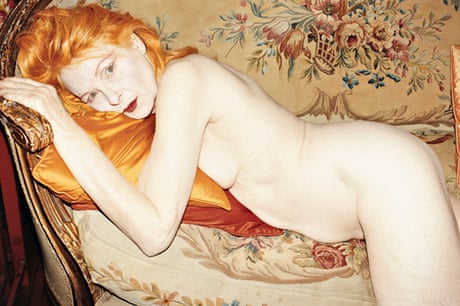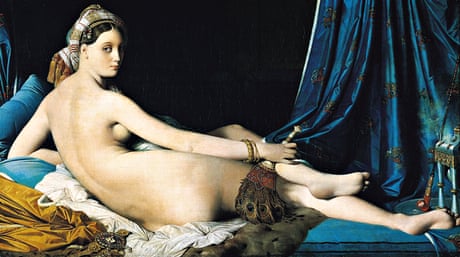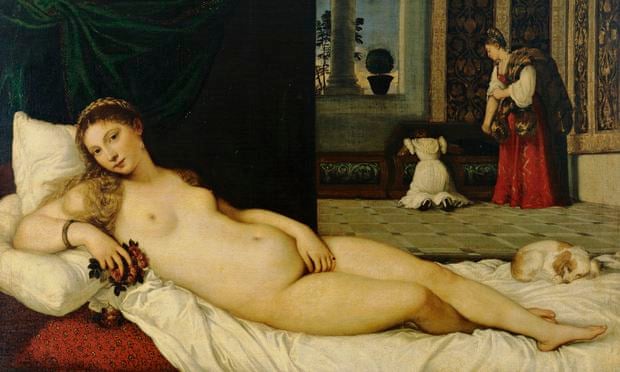The top 10 female nudes in art
From the ravishing Venus of Urbino, past Ingres's sensual Odalisque, to the feminist riposte of the Guerrilla Girls, the female nude has inspired, enraptured and enraged
Jonathan Jones
Tuesday 15 April 2014 12.06 BST
Tuesday 15 April 2014 12.06 BST
Titian – Venus of Urbino (1536-38)
No one has ever painted naked women as gorgeously as Titian did. His ravishing Venus is a lover laying her beauty bare, and the recipient of her optical largesse is anyone who happens to stand in front of this painting in the Uffizi gallery in Florence, Italy. Titian creates with mind-boggling skill the lavish presence of this nude: the rapture of her carnal glory. There's something divine about such beauty. Some people find profundity in religious art, in abstract art, in conceptual art. For me, there's nothing more moving in art than the breasts of the Venus of Urbino.
Juergen Teller – Vivienne Westwood (2013)

Nudity never loses its power. The conventions of the nude can be enjoyed, and challenged, in limitless ways. Vivienne Westwood glories in poses culled from painting as she exults in all the possibilities of nakedness in art, while in her 70s.
François Boucher – Louise O'Murphy (1752)
The mistress of the king of France proudly displays her bottom in this picture from the age of the Marquis de Sade. In the 18th century of Enlightenment and spanking, Louise O'Murphy is not just nude – she is posed erotically. The artistic tradition of the nude, which goes back to ancient Greece, is sometimes wrongly imagined to be an ethereal pursuit of classic beauty. In fact, as Boucher and his model prove, it has always been and always will be about sex.
Ingres – La Grande Odalisque (1814)

This insouciantly provocative nude is gratuitously offered to the eye of some imagined sultan. Her perfume of orientalist fantasy casts the onlooker as a decadent connoisseur of sensual pleasure. Ingres makes his Odalisque almost surreally curvy, impossibly waxen-skinned, yet more real than any photograph. Utterly amoral, this painting is a depraved engine of delight.
Guerrilla Girls – Do women have to be naked to get into the Met Museum? (1989)

In this classic riposte to millennia of male voyeurism, the Guerrilla Girls give an ape head to Ingres's nothing-if-not-objectifying Odalisque. There are more female nudes in art than there are famous women artists. Is the nude just an instrument of oppression? Are Titian and Ingres misogynists? Today, it's hard to look at the nude without asking those questions.
Pablo Picasso – Nude, Green Leaves and Bust (1932)
 |
| Pablo Picasso – Nude, Green Leaves and Bust |
Picasso imagines his lover as a welcoming cloud of pinkness, a constellation of curves, in this ecstatic painting. The woman, here, is a part of nature, reduced to the status of objects in a still life, to be enjoyed by the male artist. Yet his love, possessive as it is, cannot be doubted. Picasso puts his own sexuality into every pigment of this opulent painting. If his vision of the nude is utterly proprietorial, it is also absolutely honest.
Hannah Wilke – SOS Starification Object Series (Back) (1974)
Wilke exhibits herself as a "starification object", her body marked by the stigmata of voyeurism. In a world ruled by the male gaze, she seems to have sprouted surreal vagina-like growths under the pressure of relentlessly being stared at. This feminist perspective on the oppression of looking turns the ancient tradition of the nude in art inside out to display the pain of being gazed at.
After Praxiteles – Capitoline Venus (copied from a 4th-century BC original)
The Greek sculptor Praxiteles more or less created the idea of the female nude. In one of his lost masterpieces, which can be seen only through later Roman copies, he portrayed the goddess Venus naked in a pose that ancient Greeks found intensely provocative. At least one onlooker is said to have attempted to copulate with it. In this alternative take on his daring theme, Praxiteles gives Venus a more decorous pose – even as she is seen naked, she attempts to cover herself modestly, in a way that actually draws attention to sexuality and its dangers.
Sandro Botticelli – The Birth of Venus (c 1484)
Botticelli revived the love goddess Venus in the Renaissance, posing her in the modest manner pioneered by the ancient artist Praxiteles, as he sets out not to titillate, but philosophise. According to Plato and his followers the contemplation of physical beauty can lead the mind to heavenly truth. Botticelli's Venus is not a sex object. She is a divine teacher of spiritual enlightenment. Hers is a beauty that heals the world.
Diego Velázquez – The Rokeby Venus (1647-51)

In the early 20th century this luxuriant nude was attacked by a suffragette who slashed it repeatedly. And yet, a second look at Velázquez's subtle painting reveals that it contains its own critique of looking. As we feast our eyes on pink flesh laid out amid rich silvers and reds, the model is looking in a mirror. Her features in the glass are blurred and hesitant, her expression grave. What is she thinking of? Velázquez makes us ask. He sets up an anxious tension between mind and body, between displayed flesh and secret soul. In so doing he paints a nude not only beautiful, but profound.
THE GUARDIAN



.jpg)
.jpg)



No comments:
Post a Comment